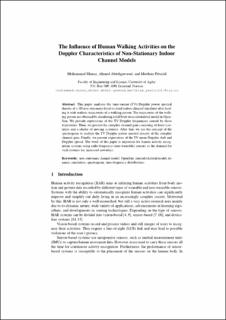| dc.contributor.author | Muaaz, Muhammad | |
| dc.contributor.author | Abdelgawwad, Ahmed | |
| dc.contributor.author | Pätzold, Matthias Uwe | |
| dc.date.accessioned | 2020-03-25T01:18:06Z | |
| dc.date.available | 2020-03-25T01:18:06Z | |
| dc.date.created | 2019-06-20T12:02:16Z | |
| dc.date.issued | 2019 | |
| dc.identifier.citation | Muaaz, M., Abdelgawwad, A. & Pätzold, M. U. (2019). The Influence of Human Walking Activities on the Doppler Characteristics of Non-stationary Indoor Channel Models. In I. Rojas, G. Joya & A. Catala (Eds.), Advances in Computational Intelligence (11506, p. 297-309). Cham: Springer. doi: | en_US |
| dc.identifier.isbn | 978-3-030-20521-8 | |
| dc.identifier.issn | 1611-3349 | |
| dc.identifier.uri | https://hdl.handle.net/11250/2648457 | |
| dc.description | Author's accepted manuscript (postprint). | en_US |
| dc.description | Available from 17/05/2020. | |
| dc.description.abstract | This paper analyzes the time-variant (TV) Doppler power spectral density of a 3D non-stationary fixed-to-fixed indoor channel simulator after feeding it with realistic trajectories of a walking person. The trajectories of the walking person are obtained by simulating a full body musculoskeletal model in OpenSim. We provide expressions of the TV Doppler frequencies caused by these trajectories. Then, we present the complex channel gain consisting of fixed scatterers and a cluster of moving scatterers. After that, we use the concept of the spectrogram to analyze the TV Doppler power spectral density of the complex channel gain. Finally, we present expressions of the TV mean Doppler shift and Doppler spread. The work of this paper is important for human activity recognition systems using radio-frequency (non-wearable) sensors as the demand for such systems has increased nowadays. | en_US |
| dc.language.iso | eng | en_US |
| dc.publisher | Springer | en_US |
| dc.relation.ispartof | Advances in Computational Intelligence, 15th Int. Work-Conference on Artificial Neural Networks, IWANN 2019, Part I | |
| dc.title | The Influence of Human Walking Activities on the Doppler Characteristics of Non-stationary Indoor Channel Models | en_US |
| dc.type | Chapter | en_US |
| dc.type | Peer reviewed | en_US |
| dc.description.version | acceptedVersion | en_US |
| dc.subject.nsi | VDP::Teknologi: 500::Informasjons- og kommunikasjonsteknologi: 550 | en_US |
| dc.source.pagenumber | 297-309 | en_US |
| dc.source.volume | 11506 | en_US |
| dc.source.journal | Lecture Notes in Computer Science | en_US |
| dc.identifier.doi | 10.1007/978-3-030-20521-8_25 | |
| dc.identifier.cristin | 1706398 | |
| dc.relation.project | Norges forskningsråd: 261895 | en_US |
| cristin.qualitycode | 1 | |
